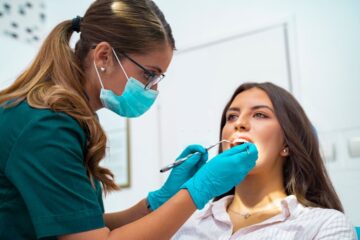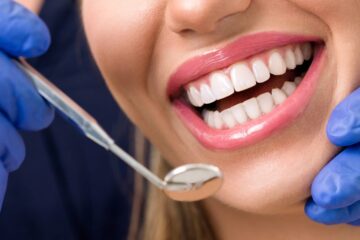Are you considering Invisalign treatment but worried about potential headaches? Well, fear not! In this article, we will delve into the question ‘Can Invisalign cause headaches?’ and provide you with all the answers and solutions you need.
Discover the ins and outs of the Invisalign treatment process, learn about common headache causes during treatment, and find valuable tips to alleviate any discomfort.
Don’t let headaches deter you from achieving that perfect smile – read on to find out more!
Understanding Invisalign Treatment Process
Understanding the Invisalign treatment process can help alleviate any concerns or questions you may have. When it comes to straightening your teeth, Invisalign offers several benefits over traditional braces.
The first stage of the Invisalign treatment involves a consultation with an orthodontist who will assess your dental condition and determine if you are a suitable candidate for Invisalign. Once approved, digital scans or impressions of your teeth will be taken to create a customised treatment plan.
Next, you will receive a series of clear aligners that are designed to gradually shift your teeth into their desired positions. These aligners are made from smooth and comfortable plastic, making them more comfortable than traditional metal braces. You will wear each set of aligners for about two weeks before moving on to the next set in the series.
One of the greatest benefits of Invisalign is its discreet appearance. The clear aligners are virtually invisible when worn, allowing you to maintain your confidence while undergoing treatment. Additionally, since the aligners are removable, you can easily take them out when eating or brushing your teeth.
Another advantage of Invisalign is its flexibility. Unlike traditional braces, which require frequent visits to adjust wires and brackets, Invisalign only requires check-ups every six weeks on average. This means less time spent at the orthodontist’s office and more time enjoying life.
Common Causes of Headaches During Invisalign Treatment
One of the common reasons for experiencing headaches during Invisalign treatment is the tightness of the aligners. When you first start wearing your aligners, they may feel snug and put pressure on your teeth to gradually move them into position. While this is necessary for the treatment to be effective, it can cause temporary discomfort, including headaches.
The tightness of the aligners places pressure on your teeth and jaw, which can lead to tension headaches or even migraines in some cases. These headaches may range from mild to severe and can last for a few hours or even days. They can significantly impact your daily activities, making it difficult to concentrate at work or school, affecting your mood, and hindering your overall quality of life.
It’s important to note that not everyone experiences headaches during Invisalign treatment. Some individuals may have a higher pain tolerance or adapt more easily to the aligners. However, if you do experience frequent headaches while wearing Invisalign, there are a few things you can do to alleviate the discomfort.
Firstly, try taking over-the-counter pain relievers like ibuprofen or acetaminophen as recommended by your dentist or orthodontist. Applying a warm compress or an ice pack to your jaw area can also help reduce any inflammation and relieve headache symptoms.
Additionally, practising stress-reduction techniques such as deep breathing exercises or meditation may help relax your jaw muscles and alleviate headache pain. It’s crucial to communicate any concerns with your dental professional so they can provide guidance and support throughout your Invisalign journey.
Remember that while headaches during Invisalign treatment can be bothersome, they are usually temporary and will subside as you adjust to wearing the aligners.
Tips for Alleviating Headaches During Invisalign Treatment
To alleviate headaches during Invisalign treatment, it’s helpful to try over-the-counter pain relievers and apply a warm compress or ice pack. Headaches can be triggered by various factors such as the pressure exerted on your teeth and jaw during the aligner adjustment process. While these headaches are temporary and usually subside within a few days, there are natural remedies you can try to find relief.
One effective way to relieve headache pain is by using over-the-counter pain relievers like acetaminophen or ibuprofen. These medications work to reduce inflammation and relieve discomfort, helping you feel better while your teeth adjust to their new position.
In addition to medication, applying a warm compress or ice pack to your forehead or temples can also provide relief. The cold temperature of an ice pack helps numb the area and reduce any swelling that may be contributing to your headache. On the other hand, a warm compress can help relax tense muscles in your head and neck, easing the pain associated with headaches.
It’s important to note that everyone’s experience with Invisalign is different, so what works for one person may not work for another. If over-the-counter remedies don’t alleviate your headaches or if they become more frequent or severe, it’s best to consult with your orthodontist. They may recommend alternative treatments or adjustments to help minimise discomfort during your Invisalign journey.
Remember that taking care of yourself is essential throughout this process. Stay hydrated, get enough restful sleep, practice stress management techniques like deep breathing exercises or meditation, and maintain good oral hygiene habits. By incorporating these tips into your routine, you’ll have a greater chance of alleviating headaches while undergoing Invisalign treatment.
Seeking Professional Guidance for Headache Relief
If over-the-counter remedies don’t work, it’s best to consult with your orthodontist for professional guidance on relieving headaches.
While there are many natural remedies for headache relief that you can try, it’s important to have regular dental check-ups during your orthodontic treatment.
When it comes to finding natural remedies for headache relief, there are a few options you can consider.
One popular method is applying a cold or hot compress to the affected area. This can help reduce inflammation and provide temporary relief from the pain.
Another option is practising relaxation techniques such as deep breathing exercises or meditation, which can help alleviate tension and stress that may be contributing to your headaches.
However, if these remedies do not provide sufficient relief, it’s crucial to consult with your orthodontist. They have the expertise and knowledge to assess your specific situation and determine the cause of your headaches.
It could be due to misaligned teeth or improperly adjusted aligners. Your orthodontist will be able to make necessary adjustments or recommend alternative treatments that can address the underlying issue and provide long-term relief.
Regular dental check-ups during your orthodontic treatment are essential for monitoring your progress and ensuring everything is going smoothly.
By keeping up with these appointments, any potential issues such as tooth decay or gum disease can be detected early on and treated promptly, preventing complications in the future.
In conclusion, while natural remedies for headache relief can be helpful in some cases, consulting with your orthodontist is crucial if over-the-counter solutions aren’t effective.
They will provide professional guidance tailored to your specific needs and ensure that you receive appropriate care during your orthodontic treatment journey.
Remember the importance of regular dental check-ups as well – they play a vital role in maintaining oral health throughout this process.
Managing Discomfort and Side Effects During Invisalign Treatment
Applying a cold or hot compress to the affected area can help reduce inflammation and provide temporary relief from discomfort during Invisalign treatment. Discomfort management is an important aspect of your journey towards achieving a beautiful smile with Invisalign.
While this orthodontic treatment is highly effective, it is not uncommon to experience some side effects along the way. During the initial stages of wearing your aligners, you may feel some discomfort as your teeth adjust to the new pressure. This discomfort typically subsides within a few days, but there are ways to manage it in the meantime.
Applying a cold compress can help numb the area and reduce swelling, while a hot compress can promote blood flow and relax tense muscles. In addition to using compresses, over-the-counter pain relievers like ibuprofen or acetaminophen can also provide temporary relief from any discomfort you may be experiencing. However, always consult with your orthodontist before taking any medication.
It’s important to note that while discomfort is common during Invisalign treatment, severe pain or prolonged discomfort should be brought to the attention of your orthodontist immediately. They will be able to assess whether any adjustments need to be made or if there are other underlying issues causing your discomfort.
Remember that everyone’s experience with Invisalign is different, and what works for one person may not work for another. Be sure to communicate openly with your orthodontist about any side effects you are experiencing so they can provide personalised guidance and support throughout your treatment journey.
Frequently Asked Questions
Can Invisalign treatment cause tooth sensitivity?
Yes, Invisalign treatment can cause tooth sensitivity and oral discomfort. You may experience tooth pain as your teeth gradually shift. This is a normal part of the process and should subside over time.
How long does it take for headaches to subside during Invisalign treatment?
The duration of headaches during Invisalign treatment varies for each person. However, many patients find that their headaches subside within a few days to a couple of weeks. Invisalign has been effective in reducing headaches for some individuals.
Are there any specific food restrictions during Invisalign treatment to prevent headaches?
During Invisalign treatment, it’s important to follow some food restrictions to prevent headaches. Avoid hard or sticky foods that could damage the aligners. Opt for softer foods and remember to chew slowly and carefully.
Can wearing Invisalign trays at night cause headaches?
Wearing Invisalign trays at night can affect sleep quality, leading to headaches. Studies show that 48% of Invisalign users experience discomfort due to the trays, which may contribute to headaches and disrupted sleep patterns.
Are there any alternative treatment options for headaches while undergoing Invisalign treatment?
While undergoing Invisalign treatment, if you experience headaches, there are alternative headache treatments available. These options include managing stress, practising relaxation techniques, using over-the-counter pain relievers, and consulting with your orthodontist for further guidance.
Conclusion
So there you have it – the answer to the question, ‘Can Invisalign cause headaches?’
While it is possible to experience headaches during Invisalign treatment, they are usually temporary and can be managed with some simple tips and tricks.
Remember, an interesting statistic shows that approximately 20% of people who undergo orthodontic treatments like Invisalign may experience headaches at some point.
But don’t let this deter you from achieving a beautiful smile! With proper care and guidance from your dentist or orthodontist, any discomfort can be minimised, allowing you to enjoy the benefits of Invisalign without unnecessary pain.





